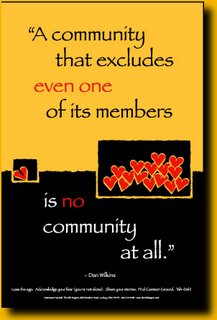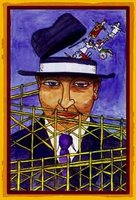This semester in my English course, my classmates and I were asked to write an essay about education. I decided to write about my childhood educational experiences because I thought they needed to be heard. When my English teacher and my classmates read my rough drafts, they did not readily grasp the main points that I was making and they totally missed some of the subtler points. Granted, they were unpolished drafts, but the reality was that my childhood educational experience may have taken place on another planet for all that they could relate to it. I ended up making many changes to the paper, changing words and fleshing out concepts so that my classmates could better understand the school experiences that I and many other children with disabilities had. To focus on a more basic message I ended up leaving out some of the complexities, for example: juggling health needs and school; countercultural decisions that my parents and I made in an attempt to counter the mainstream paradigm; and my atypical high school choices.
My experience with this essay left me thinking. How do you best convey experiences of living with a disability that are so alien to so many people? Where do you start? How do you convey challenges that people have never even considered? (Kay and Ruth recently shared recent experiences that most people couldn’t even fathom.) How can people relate to you and support you when they are so unfamiliar with your experience? I realized after I wrote my paper how grateful I am to have the support of the blogging community, many of whom share personally their own journeys through different, unfamiliar, and exotic lands. I'm so grateful that I have people that know what I'm talking about and are not surprised when I bring up certain issues in my life. Psychologically, it's really helpful to realize that there are, in fact, a large number of people who have atypical life experiences and that we can and do support and encourage each other. This experience of trying to convey my world to people who could not easily envision it led me to an even greater appreciation for Amanda Baggs and her tireless efforts to share her perspective in a society that lives under such a different paradigm.
So on this Thanksgiving, I thank you fellow bloggers. I thank you for all you've taught me and all you've done to support me. I thank you for listening to my perspective and enriching me with yours. And I thank you readers for making the effort to understand my perspective.
Here’s the final version of my English essay:“We hold these truths to be self evident, that all men are created equal, that they are endowed by their Creator with certain unalienable rights, that among these rights are Life, Liberty, and the pursuit of Happiness.” Familiar words to all Americans; and within these words, most Americans see the value of education, believing that public education is a key component of the individual pursuit of “Happiness”, a full and rewarding life. And likely, most of us agree with Thomas Jefferson’s 1806 assertion in his 6th Annual Message that the country as well as the individual is improved when its citizens are educated, that the benefit of education is not just to the individual, but also to the entire society, which is strengthened and enriched by educated members.
One group of Americans left out of this fundamental right is children with medical conditions or learning differences. The current educational system is designed for the student who can sit at a desk for several hours at a time; learn visually from the written word; follow directions quickly, easily, and compliantly; and conform and cooperate with the demands of a system based on multiple choice testing as the means of assessing progress. The American educational system is a one-size-fits-all structure that doesn’t fit the large number of students that are unable conform to it.
So what happens to these children who don’t fit the system? The children who can’t sit still, the children who learn best from hearing rather than seeing? The children who have difficulty understanding directions? The children who can’t write for themselves? The children who learn best with movement and physical stimulation? The children who are slower or faster in learning a skill than their same-aged peers?
These children are disrespected and left along the wayside. They are labeled - “different”, “uncooperative”, “special”, “hyperactive”, “slow”, to name a few. Expectations for these children are lowered, dramatically lowered. In our society, there are two ways of educating children with learning differences: in a classroom exclusively for children with disabilities or within a classroom with same-aged peers. Because of the pervasive disrespect and low expectations for these children, neither setting is designed for success. Often the curriculum is weak, the support non-existent or poor, the staff undertrained, and the resulting social isolation is vast.
Having cerebral palsy, I was one of the children labeled “different”. I have traveled through a dark side of public education that may surprise, and would hopefully appall, many Americans. Over the last year, I have interviewed young adults with disabilities from many school systems who have shared similar dark educational journeys.
Ironically, my very first school experience was an ideal experience, a model for the education of young children. My parents had refused to let me, as a 3 year old preschooler, travel 1 ½ hours each way by bus to be isolated in a building that only had students with physical weaknesses like mine. They recognized that while my physical abilities were quite limited, my language skills, love of music, interest in books, and desire to learn were age appropriate. Luckily, a local preschool teacher invited me into her classroom for the second half of the schoolyear, while a neighbor physically lifted me and supported my full participation. Not until much later would my parents and I realize that this ideal educational experience based on high expectations, respect for me and my learning style, and full membership amongst my peers was a fortuitous rarity that would not be easily replicated in my grade school years.
In grade school, my parents pushed for me to be in a classroom with my same-aged peers, but like other children with disabilities in the regular classroom, it was a forced fit. The biggest hurdle that I faced every single day was the hurdle of low expectations. Many staff took one look at me and made assumptions that I couldn’t learn, that it would be a chore to teach me, that it didn’t really matter if I learned, and that I was not now nor ever going to be a contributing member of the classroom or society. I felt these low expectations when teachers didn’t expect me to have an answer and would not call on me in class, when an inaccessible location was chosen for a field trip and it was okay if I didn’t go, when it was acceptable that my schoolbook audiotapes were not available at the start of a unit, and when my large print copies were not ready on time.
My stories are echoed in the stories of the people I have interviewed. Whether in a disability classroom or a same-aged classroom, each person experienced the trauma of low expectations. Students in disability classrooms noted that academics were not considered a priority, that they did not have homework, and that their schoolday was full of wasted time. Students in the same-aged classroom recall the discomfort of the forced fit into that classroom – the medications to allow them to sit still, the assumptions that they were faking their need for extended time or personalized directions, having to learn math with worksheets rather than by handling concrete objects. A woman who is blind recounted the terror of never knowing when she would be hit by a basketball in gym class. (The sound of a basketball still makes her cringe some 20 years later.) Whatever their classroom, most can still replicate the baby-talk voices of staff members. Students who took the “special bus” recalled that no educator seemed to care that each day they would miss academic instruction due to a late arrival and early dismissal designed to make the bus driver’s schedule easier.
For many, a seismic manifestation of the disservice of low expectations came in the form of teachers’ assistants. Assistants to support students with disabilities in the classroom sounds, in theory, like a good idea. Reality often shows otherwise. Using a wheelchair, being unable to handwrite, and being a weak visual learner, I was assigned an assistant to support me throughout grade school. More often than not, this was a person who had no more than a high school education and was in this very low paying job temporarily until a better job came along. Typically, my assistant had little to no understanding of child development and placed no value on his or her own education. Yet, these people were placed in charge of my day-to-day learning, while the classroom teachers looked after the needs of the other 25 students. I had a few positive assistant experiences, but many more negative ones, including an assistant who was absent 50% of the time; an assistant who wrote “Abe” rather than “Abraham” in my dictated story about President Lincoln because she could not spell “Abraham” and did not think of using a dictionary or asking the teacher; an assistant who would take me with her while she socialized with the janitors; several assistants who did not know school policies or equipment; an assistant who forgot to put my seatbelt on, then tried to push my wheelchair forward down the stairs (fortunately stopped by the scream of my observing mother); assistants who brought their own troubles and stress to the workplace and my day; and an assistant who swore at me and abandoned me in the bathroom because he didn’t like my attitude.
Like me, others interviewed told of low expectations manifest through the revolving door of incapable and, occasionally, even abusive, assistants. A number of people recalled that recess was nothing more than a time for assistants to gather, students at their side, for a chatting break while all the other kids played. Former students spoke of the high absenteeism rate for assistants, and of assistants who yelled at and scolded them. One man shared that an assistant kissed him in the seclusion of an elevator.
When so many actions of the educational system send the message that you have little potential, it’s hard for a child not to internalize and fulfill those low expectations. The public educational system wreaks havoc on the feelings of self-worth of the child with a disability. Every person that I have interviewed speaks of childhood memories of intense isolation, deep rooted feelings of inferiority, and an assault on their self-esteem. For many, the scars take years to eradicate, and can resurface when confronted by constructive criticism, snide comments, a rude look, or any challenging situation. Changing from a “you can’t do that” mentality to an adult “I can do that” attitude requires great effort.
Children model adult behavior, and the plague of low expectations spreads to little ones without disabilities as well. These children have been exposed day after to day to a system that treats a group of their peers as inferior, and they naturally come to accept that perspective. In addition, if there is segregation of the two groups of students within the school, there is limited opportunity to get to know each other and break down the stereotypes. Children could have the opportunity to form friendships in extracurricular activities, but sadly this doesn’t happen very often. Children with disabilities are only able to partake in activities with leaders willing to accommodate their differences, which are not necessarily activities for which they have a natural affinity or a genuine interest.
Consequently, many children with disabilities never experience solid friendships with their able-bodied peers. By the teenage years, many schools aggravate this problem by setting up well-intentioned service opportunities for their able bodied students, pairing them with students with disabilities for social activities. What I have seen repeatedly is that the able-bodied student sees a short term charitable project, albeit a fun one, while the student with a disability, lacking experience with relationships, believes he or she has formed a real, lasting friendship. This disconnect often is never fully realized by either side, and down the road leads to confusion, hurt feelings, and sometimes hostility, exacerbating the divide between the two groups.
It can be seen, then, that the child with a disability loses out on academic instruction and therefore academic potential, self-esteem, and relationships. But, others suffer too. Able-bodied children lose the opportunity to be exposed to peers who have a different perspective on some life issues, and society loses the opportunity to fully experience the talents and contributions of this suppressed group of people.
The current system, defined by low expectations for students with disabilities doesn’t work. What is needed is an educational system that accepts all aspects of diversity, including diversity of ability. What is needed is a school system that truly respects each individual child and supports all children to become full members of a diverse society that benefits from the full education of each of its members. There is not some precise line dividing the ability from disability. Every child, and for that matter every person, has abilities along a continuum. In addition, each child has individual strengths and weaknesses. Priorities should be set so that not only can weaknesses be improved, but strengths, interests, and passions can flourish.
Class sizes need to be smaller, so that teachers can get to know each student and his or her unique needs. Lessons should be offered in many formats – visual, auditory, kinesthetic, creative role playing, tactile, and experiential. Each format needs to be considered to be of equal merit, deserving of high quality materials that are ready in a timely fashion. The ideal classroom would be reflective of the ideal society, having diversity represented among the staff as well as the children. Diversity of ability should be prized in teachers, as enriching the educational process and society. A teacher with a kinesthetic learning style, one who might have been labeled as uncooperative and wiggly in first grade, would be a valued member of a team with teachers of other learning styles.
This truly respectful environment would foster self-worth, confidence, and a joy and love of learning. In a school with respect for individuality and diversity of ability, natural peer relationships and friendships would develop without the barriers of artificial superiority or inferiority. Children would grow up to offer their self-confidence and varying talents to create a just, diverse society enriched as Jefferson imagined through the foundation of a strong public education system.























